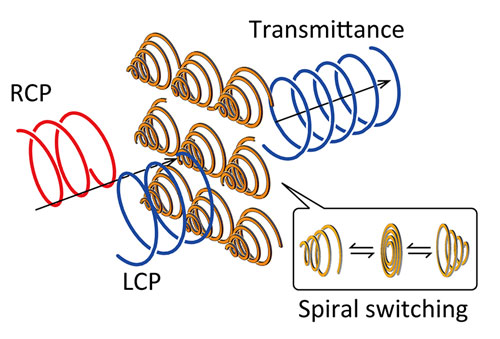| Posted: Jan 18, 2016 |
Reconfigurable micro spirals control light
(Nanowerk News) A University of Tokyo research group has developed an active polarization filter which is able to switch the circular polarization state of light between right and left in the terahertz frequency region at wavelengths of several hundred micrometers ("Enantiomeric Switching of Chiral Metamaterial for Terahertz Polarization Modulation Employing Vertically Deformable MEMS Spirals").
|
 |
| A schematic illustration of polarization modulation by the spiral metamaterial. Passing light through a metamaterial composed of an array of reconfigurable metal spirals changes its polarization state. By changing the direction of the conic helices, the circular polarization of the light transmitted through the material can be switched from left to right and vice versa. (Image: Tetsuo Kan)
|
|
Spectroscopy using polarized light, in which the direction of oscillation of the light’s electric field is aligned, enables us to obtain detailed information about materials. Moreover, dynamic switching of polarization enables even more precise measurement. However, the lack of a simple device that can actively switch the polarization state of light in the terahertz region has prevented the development of technologies employing polarized terahertz light.
|
|
The research group of University of Tokyo Graduate School of Information Science and Technology of Professor Isao Shimoyama, Graduate School of Science Professor Makoto Gonokami (currently University President), and the Graduate School of Information Science and Technology Assistant Professor Tetsuo Kan, and Graduate School of Science Assistant Professor Kuniaki Konishi developed a terahertz metamaterial device to dynamically switch the polarization state of terahertz waves. |
|
The metamaterial is composed of an array of reconfigurable metal spirals, which are 150-?m in diameter, using micro electro mechanical systems (MEMS) technology. Applying force perpendicular to the plane of the spirals causes the spirals to deform, creating three dimensional conic helices.
|
|
Depending on the direction of the force applied, the conic helices become left-handed or right-handed respectively. This handedness alternation brings about the switching of the polarization state of the transmitted light. Mechanically changing the handedness of the micro spirals has been difficult to achieve in a small, three-dimensional structure, making this the first time it has been achieved.
|
|
“The use of MEMS techniques made it possible to realize this structure,” says Professor Shimoyama. He continues, “Since the spectra of a material with respect to circularly polarized light contains clues to its three-dimensional molecular structure, this device may, for example, enable the development of technologies for easily obtaining information about large structural arrangements in materials with this new approach that is would otherwise be difficult to obtain from analysis of X-ray diffraction patterns. In the future, it may be possible to realize compact analytical instruments that can perform on-site analyses of dangerous drugs or other materials.”
|

